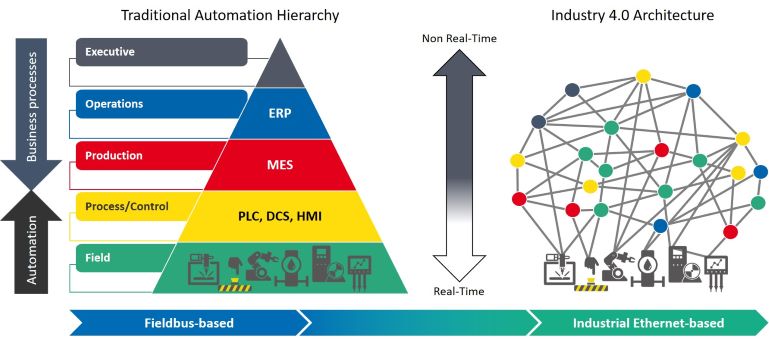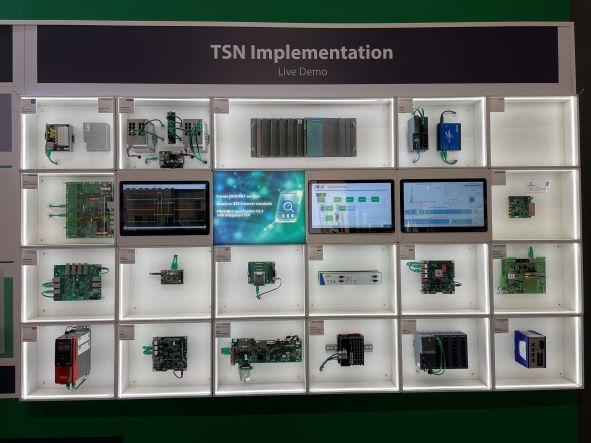TSN is considered key to network convergence – getting sensor data, process data, asset data, really any data from the OT network, to the cloud for analysis. The results from this analysis are then used to make adjustments to processes and take actions by the devices in the OT network to improve operational efficiencies, tweak recipes, optimize power consumption, you name it. All of this so factories can produce more with less.
Fieldbuses of the past could only support one protocol and this set up data islands. Getting access to data meant gateways, proxies, or special programs to extract data out of these islands. And there needed to be a gateway or proxy for each of the fieldbus protocols. The benefit of the gateway/proxy approach is that the operational actions taken by devices were not affected by access to data. With Ethernet, multiple protocols can run on the same wire. So, there is a risk that OT protocols on the network get overrun by all of the other protocols – i.e. non-OT protocols use up the bandwidth required by OT protocols to run the factory.

TSN fixes this. It protects the OT protocols’ traffic from interference by the non-OT protocols’ traffic. TSN allows us to go beyond mere coexistence of protocols on the wire to prioritizing a protocol’s traffic and ensuring its delivery. In this way, TSN is like an insurance policy so data gets to where it needs to go on-time, every time. And TSN goes a step further than just determinism, it is also about reliable delivery of data. It provides a way for traffic to find alternative paths through the network that can deliver data on-time. This will lead to a world of alternative network architectures beyond the hierarchal structure of the past.
When we speak of TSN, we tend to speak of it as a monolith. This “one thing” that will forever change Ethernet. In reality, TSN is a set of features that are being rolled out based on market needs. So, from this standpoint, TSN isn’t prevalent at all today. It is making its way out of R&D labs and into prototype demonstrations being showcased in various industry organizations. These prototype demonstrations are showing us that there are different ways to use TSN and you don’t need to use all of the features to take advantage of TSN. For certain use cases, perhaps time synchronization, preemption, and prioritization are enough. For other use case, maybe time synchronization, scheduled traffic, and seamless redundancy are required. And as use cases evolve, so will TSN. So, while TSN may not be prevalent today, it will be soon, and it will continue to evolve as networks advance.
It all started back in the day with the establishment of Audio Video Bridging, or AVB. This laid the foundation for the expansion of Ethernet into what we now call TSN. The IEEE formed the TSN Task Group back in 2012 and this group spent the next several years hard at work putting together a series of specifications that we now consider the TSN toolbox. This effort is ongoing, but their work culminated in the release of the major TSN features in 802.1Q-2018 and 802.1AS-2020. Even as these releases were happening, TSN was continuing to evolve and it became clear we needed a way to apply TSN to various use case within different market verticals. This realization led to the establishment of a series of “Profiles” with each profile defining their own use cases and how to apply TSN to their market. The establishment of IEC/IEEE 60802 is key for how TSN will be deployed in Industrial Automation. Likewise, IEEE 802.1DG defines how TSN will be deployed for Automotive and 802.1 DP defines how TSN will be deployed for Aerospace. And we should not overlook the profile that started it all with AVB and their profile, 802.1BA. And of course, none of this is static. TSN is continuously improving with the evolution of the specifications and with the profiles figuring out better ways to use TSN for their market. New profiles are also coming online as markets see value in bringing TSN into their space. Think of it this way, TSN specifications tell us what TSN is so we can build silicon and software. TSN profiles tell us how to use TSN in a particular market so we can build boards and systems to meet particular application needs.
With all of this said, it is important to understand that, in late-2022, it is still early days for TSN. Various organizations are helping to build out the TSN ecosystem for their markets. Some markets are further ahead than others. So, users need to look around the market they are in and find out if a TSN profile exists. If it does, then they can find guidance from the organizations supporting the profile. For example, in Industrial Automation, we have the IEC/IEEE 60802 profile and the organizations that are helping build out the TSN ecosystem are Avnu, CLPA, ODVA, OPC, and PI. Users can get involved and find out how they can help the ecosystem mature. At this point there are a lot of prototyping efforts and plugfests to help understand specification versus implementation issues as well as nuances with interoperability. Industrial Automation is also on the cusp of defining TSN conformance and what it means for the various protocols used in the market. Other profiles are going down similar paths.
Perhaps the clearest example that TSN is becoming a key technology for Industrial Automation is the growing number of “proof-of-concept” devices in the industrial market. At the recent SPS trade fair at the beginning of November 2022, PROFIBUS & PROFINET International (PI) showcased a set of devices that support PROFINET over TSN (see picture below). In this demo, the TSN features highlighted were 802.1AS Time Synchronization and 802.1Q Preemption running at Gigabit speed. Each of the solutions use different silicon and software along with the PROFINET stack that supports TSN. The main point here is that the technology is maturing and the ecosystem is growing. There is an evolving set of silicon solutions work for various applications from simple field devices all the way to complex controllers in the case of PROFINET. The PROFINET community can help with stacks, integration advice, and testing devices together in a lab setting.

All in all, given where we are with TSN technology in late-2022, the question now isn’t if TSN will happen it is when. Care must still be taken to avoid development pitfalls and setting false market expectations. In the Industrial Automation market, the TSN ecosystem is maturing, a TSN network configuration and management scheme is on the cusp of being standardized, and a TSN conformance testing approach is starting to materialize. Organizations like PI are helping mature the ecosystem, IEC/IEEE 60802 is making great progress on the profile including network configuration and management, and TIACC was formed by Avnu, CLPA, ODVA, OPC, and PI to start building the conformance test approach. Things are progressing, but putting a definitive time frame on when all of this will come together is tricky. Some are saying by the end of 2023, others are saying 2024. Regardless of the exact time frame, TSN is a key technology that will usher in a whole new world of network convergence and interoperability.
